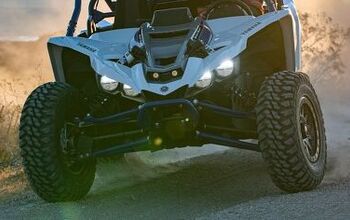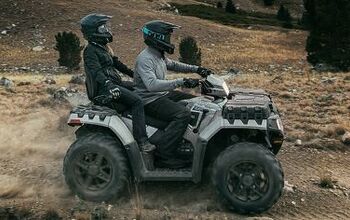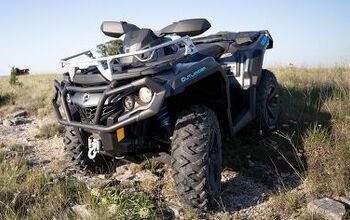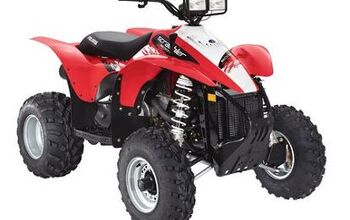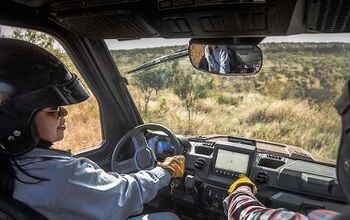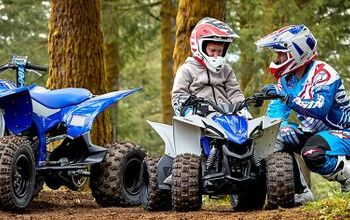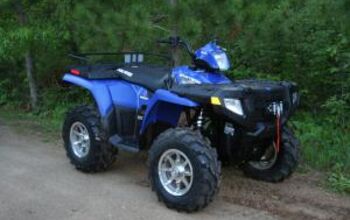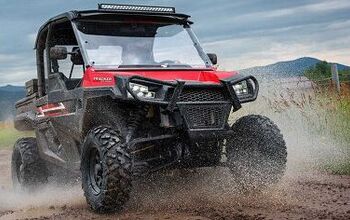Yamaha YXZ1000R Turbo vs Polaris RZR PRO XP
We decided to see how the new Polaris RZR PRO XP compares to the Yamaha YXZ1000R Turbo (with GYTR Turbo kit) in this head-to-head battle.
Nestled among saguaro cactuses and Joshua trees was a solid eight-mile test course that we created to test the heck out of a pair of popular two-seat performance UTVs – the Polaris RZR PRO XP and Yamaha YXZ1000R SS SE with GYTR Turbo kit. The track, located out in the Sonoran Desert, was composed of flat terrain, dirt, sand dunes, two-track trails, rocks, whoops, and solid inclines and declines. It took weeks to map out and run the course in preparation for this shootout, but we wanted to make sure all bases were covered. They were. Oh, and we tested both vehicles in 100-degree heat to see what they could really handle. The ice cooler was definitely our friend.
Dodging sidewinder tracks in the early morning hours, we initially took both UTVs out together to run the track a few times, while making notes about the suspension, handling, performance, comfort and features of each vehicle. While different vehicles, both have a turbo; the Polaris RZR PRO XP is turbocharged from the factory, whereas the Yamaha GYTR Turbo system can be added on at your dealership (or installed on your own).
To give you a quick comparison of these vehicles, think of the RZR as your crazy, wild uncle who every holiday likes to take the kids for wheelies down the street on his dirt bike while their parents (maybe that’s you?) watch from the driveway a bit nervously. The Yamaha is your calm, cool and collected brother who chuckles at the charades. He has a twinkle in his eye, and without so much as a comment, hops on his own dirt bike and jumps it on a ramp set up over the pool.
That’s just it, though, while these UTVs are both from a similar UTV family, they have incredibly different genetics and makeup. The Yamaha YXZ1000R Turbo is smaller, a little less aggressive in styling, but offers one epic ride that takes maximum drivability into consideration. The Polaris RZR PRO XP is larger, more aggressive in appearance, and offers a wild and squirrely ride.
Intrigued? Read on.
2019 was a big year for the Yamaha YXZ1000R as massive changes were made to the vehicle. The radiator was moved to the rear of the vehicle and increased in size. The suspension was heavily updated to include a dual-rate spring system (with crossover adjustment) on most models. The tire size was increased to 29” overall and all of the components around the tires got bigger – bearings, brakes (with stainless lines now), bolt pattern (now 4×156), and more. The engine also got some attention with a couple key changes, including the upgraded internal rods that gave this YXZ1000R the ability to be hooked up to the GYTR Turbo system without any internal engine work – simply bolt on the turbo and you’re good to go!
The other big change for 2019 was the transmission gearing, which was lowered significantly over previous model years. In real time, the YXZ can now comfortably crawl at 5-6 mph up steep climbs. If you’re thinking that the YXZ is going to be a great rock climber now, you’d be disappointed when you got it out into the real world. The gearing still needs to be lower to really tackle the crazy rock climbs at slow speed.
We’ve gone over some of the changes, so let’s take a deep dive. Upon first glance, the YXZ1000R is a quality-driven UTV. The painted plastics are very high quality. You’re going to hear this several times, but we have over 1800 miles on this machine (with the GYTR Turbo kit, too!). It has held up amazingly well, and the exterior plastics still shine like they are brand new. Even through all the sharp trees that we have been driving around, the white gleams and the graphics have really held up. The quality continues to the inside. Nothing rattles and nothing comes loose, even on the bumpiest of trails; a true testament to the Yamaha quality here. The engine starts the same, every time, no worries there. Bolts don’t come loose. We’ve gotten used to the “check it over” routine every ride because you don’t come home with things to fix on a Yamaha YXZ1000R. The chassis is gusseted in all of the right areas, and the quality of the components is great. For example, the front ball joints are massive compared to the RZR, and the A-arms are of great quality right from the factory. The chassis doesn’t flex on you when traversing gnarly terrain, and the interior doesn’t crack over time. Everything just works, every time, and there is a lot to be said for a quality-focused vehicle like that! The only thing we’d like to see added is a metal skid plate under the rear differential for more protection. The plastic works, but more protection would be welcome.
The quality of the YXZ continues towards the interior where we find well bolstered seats finished off with Yamaha’s accessory four-point harnesses. We wish these harnesses came stock. The driver’s seat has a good slider mechanism, and this YXZ has a superior view out the front of the vehicle, especially with the modified ROPS cage for 2019. The flat top and higher front part of the cage gives the driver more visibility out the front, and the lower plastics still have that awesome low profile mounting that gives the driver a view right in front of the wheels. This is the best visibility in the industry. The overall seating position in the YXZ1000R is more compact with less room to move around. However, you feel like you’re in a race car in this YXZ with the driving ergonomics and sightlines. Your heels have a very nice bump in the footwell for added support when the trail gets rough. And, the full half doors shut with confidence and stay shut. These are solid doors that don’t rattle whatsoever.
From a comfort and technology perspective, the YXZ has a good gauge cluster that tells you everything you need to know in a straightforward layout. It’s not as modern as the RZR PRO XP’ss, but it does everything you need it to do. Our test Yamaha YXZ1000R Turbo is outfitted with the Adventure Pro system, which is the best factory-optioned integrated technology suite to rival Ride Command. While it still isn’t quite as good as the built-in Ride Command system, the Adventure Pro does have the exclusive ability to be taken out of the YXZ and used in your street vehicle (or other off-road vehicle) for navigational purposes. In our YXZ, the Adventure Pro system does a good job at keeping the driver and passenger updated on machine vitals, and the Magellan GPS integration is great if you’re tracking routes, laying out a track, etc… A bit higher resolution screen would be a very nice upgrade in future iterations.
For storage, this is where the Yamaha is a bit lacking, especially compared to the RZR. The YXZ has a glove box, but that is the only enclosed compartment in the vehicle. The center dash storage is nice, but we wish it had a cover or some sort of way to keep items in the compartment. The rear cargo area is also a place where we find some great storage options, including very nice metal tie down hooks. But the overall amount of storage area is lacking, especially when compared to the RZR. And we’d like to see some kind of containment system, like a lip in the bed or something, that allows you to keep your rear cargo better secured.
The numbers don’t always tell the story, but for those of you interested, the Yamaha YXZ1000R Turbo produces a claimed 60% increase in power from the stock engine. This puts the output right around 180 horsepower, which is pretty much an exact comparison to the RZR’s 181 horsepower. The front-mounted intercooler feeds the rear-mounted charged air cooler, which helps to feed the engine with cool air. A new ECU comes with the GYTR kit, too. No other updates are needed as all of the stock driveline is designed to handle this turbo kit. Speaking of the stock driveline, the YXZ has a fully locking front differential that isn’t an on-command unit. Similar to how this YXZ offers the driver ultimate control in other areas, the front differential is the same as it allows you to put it in either 2WD, 4WD, or 4WD fully locked mode. You decide what is best based on the terrain and all testers appreciated this controllability.
If the Yamaha is the sporty spice of the duo, the RZR is the brute. It’s bigger in almost every dimension, has a more open and airy cabin, has dimensionally more cargo capacity, and has a massive ride height from the factory.
From the inside out, the Polaris RZR PRO XP is an all-new design for 2020. The chassis is now a one-piece design – no more bolts holding it all together, which is a wonderful thing. You really feel the newfound chassis rigidity from the driver’s seat when you’re pushing this vehicle hard, but more on that later. Upon closer inspection of the chassis, there are more gussets and better designs everywhere you look. The front bulkhead area is beefy, and even the outer cage (ROPS system) is larger with 2” diameter main frame rails extending from the front to the back of this RZR.
The outside looks of these new PRO models can be polarizing to some people. However, after living with these for the past several months, I have quite enjoyed the looks of the front of the vehicle. The 4-seater PRO-model carries the sidelines a bit better than the 2-seater, and we wish this two-seater had the full half doors like the PRO XP 4 instead of the rear cutouts in these (rocks still wrap around and get inside the cab). But overall, these doors are much improved over past RZR models. The rear section off the PRO XP still looks tough and offers a lot of functionality. The high fenders allow you to get to service items, and the rear cargo bed is really a great design. You can fit a large plastic construction box in the back if you want, and there are plenty of tie down hooks that can utilize full size tie downs. The cargo bed also completely removes with just 4 bolts, giving you full access to the engine and all service components. Again, this is a stellar design feature, especially for all of you do-it-yourself maintenance people like us.
The last thing about the exterior is the sloped front fascia design, which is pretty darn good for visibility while still retaining that aggressive look. While still not as good as the Yamaha’s forward visibility, the PRO XP has a good compromise between a low seating position that still retains good outward sight lines with these low front plastics. The front bodywork doesn’t have any humps for the tires that impede your view, so that is great.
Getting into the PRO XP is traditional RZR faire with easy to access, push button door latches. It’s really a matter of personal taste whether you like this forward latched door or a traditional rear latched door like the Yamaha has. There is a large hump in the side of the RZR that you swing your leg over to get in, but we like this from a safety standpoint when you’re inside the vehicle. The RZR feels more like a “cockpit” now than ever before, with a lower seating position, more adjustable steering wheel, better sight lines out the front, etc… Sitting in the revised seats, these are night and day better than the old RZR seats. No more rattling or loose connection, these are the real deal. Plus, the seat slider, is much improved! Even more, you can dial in the vertical height of the seat with 3 different tilt adjustments. All of our testers liked the middle setting, but it all depends on leg lengths. Needless to say, with all of the seat adjustment capability and the fact that the steering wheel is now the industry’s only telescoping and vertically adjusting steering wheel, the driver’s position in the RZR is dialed in.
Our Ultimate package had the standard Rockford Audio system, Ride Command 7” glove touch display, and Fox Live Valve shocks with Dynamix active suspension. Needless to say, you pay more for this technology, but there is a lot of it with the Ultimate package. Right off the bat, the Ride Command system is the best built-in technology suite in the industry right now, and the User Interface (UI) is really a straightforward and easy to use system. We love the GPS capability, and the fact that this system can be controlled with the steering wheel-mounted buttons now is really neat. For off-road driving, steering wheel controls are super handy and safer for everyone. In addition to steering wheel controls for the Ride Command system, there are also controls for the Dynamix suspension adjustments right on the steering wheel. If you’re not familiar, Dynamix suspension has been on Polaris RZRs for a few years now, and it automatically adjusts the compression in the four shocks. The system takes into account all kinds of inputs, including throttle position, brake position, steering wheel position, etc, and automatically adjusts the compression in each individual shock to give you the best ride and drive quality. The driver can also tailor the suspension by selecting from Comfort, Sport, or Firm modes with the simple press of a button on the steering wheel. This gives your suspension system a more dialed in feel for the type of riding you’re doing. If you’re going fast, you’re going to want it in Sport or Firm modes. If you’re cruising, Comfort is the way to go, giving you ample compliance over the rough stuff. This system is awesome for people who like technology and like the “do it for you” stuff already built in. Where the YXZ’s suspension is infinitely adjustable and ready to be dialed in with your own expertise, the RZR’s gives you less personal say in the suspension settings and more of a digital landscape that takes care of it for you. To each their own.
In addition to the interior being comfortable, there is plenty of room for all of your “stuff”. There are two glove boxes on the top of the dash – one in the middle and one on the passenger side. There is also a nice center console that will hold several items, along with two cup holders built in. The two dash-mounted storage areas are nice, but you can’t really see in them when sitting down. The retractable six-point harnesses make it easier to lean forward, but that brings up another point. We love the fact that Polaris has included much better seat belts from the factory (three-point harnesses are almost gone in all RZR models, yes!). However, six-point harnesses might be unnecessary. We find that four-point harnesses are plenty sufficient for most mortals. The fifth and sixth point belts dig into your thighs on these.
Last but not least, let’s discuss the powertrain of the Polaris RZR PRO XP. While the layout is still the same from previous RZR Turbo models (ProStar turbo parallel twin cylinder engine mated to a CVT transmission with on-demand AWD), the PRO XP gets several updates that will surely make their way down to other RZR models in the future. There is better cooling now throughout, and even the cooling lines have been better supported so they aren’t flopping around like on past RZR models. The CVT clutching is essentially all-new with high quality clutch components used and better clutch weighting used. There is something to be said for how good this clutch system has gotten over the years, especially when you consider that past RZR models had great clutching from the factory. You can also see the quality increase with all components used on the Turbo system. Compared to any past turbocharged RZR, this PRO is built better, has much better cooling, and just has better quality than anything Polaris has put out. All of the 181 factory turbocharged horsepower is routed through the well liked AWD system, which includes bigger axles, the awesome Polaris front differential, and stronger externals.
When you put all of this together, how do both of these machines fare?
Let’s cut right to the chase here… Where the Polaris RZR PRO XP is the brute of this comparison, the Yamaha YXZ1000R Turbo is the Swiss army knife. Where the RZR marches its way through corners with less finesse, the YXZ gracefully dances through them with finesse and an incredible driving dynamic. Where the YXZ has less storage and less interior room, the RZR has a great amount of cargo space and a more open interior to fit a wide range of people, making it a better long distance adventure machine from the factory. Where the RZR offers a less thrilling and more sewing machine style of driving dynamic with the CVT setup (but can also be very fun with immediate throttle response), the YXZ begs you to drive with a thrilling, paddle shifted and waste gate sounding experience. Where the YXZ has a zippy sound to it that can be thrilling at high RPMs (bystanders can’t get over the aircraft-like sounds coming from this turbocharged engine and stock exhaust), the RZR has that deep throaty tune that so many people in the off-road industry love to hear.
We aren’t trying to say that the Polaris is a bad driver, but it just doesn’t have the finesse of the YXZ. When the RZR goes through a corner, the front and rear of the vehicle just don’t quite communicate correctly. The front hits the berm, then the rear hits, and it’s all difficult to get it to mold together into one flowing motion from the driver’s seat. If you ride in an area where there aren’t two-tracked trails and mostly open fire roads, then you’ll probably like how the Polaris RZR PRO XP can be easily steered with the rear of the vehicle, and, of course, some throttle-happy fun times. The stock 30” Maxxis Carnivore tires do a good job at hooking up for forward bite, but they still can’t quite match the Bighorns on the Yamaha YXZ1000R Turbo for consistent, predictable traction.
One thing that the RZR does very well is stay flat in the corners. Between the front and rear sway bars, plus the fact that the Dynamix suspension automatically adjusts the outside shocks to increase compression when you’re going around a corner, the Polaris RZR PRO XP stays very flat. This could also be a big factor as to why it doesn’t pivot smoothly when going around a corner; it’s almost working against itself. Luckily, the drivetrain is still extremely fun. The ProStar engine and CVT transmission combination don’t give you the thrill of shifting gears like the YXZ has, but the CVT transmission makes slow speed crawling so much easier compared to the YXZ. Where the YXZ crawls at 5mph, the PRO XP crawls easily and smoothly at 2mph, and starting from a dead stop on a hill is also much easier and smoother in the PRO XP than the YXZ.
By contrast, the Yamaha YXZ1000R Turbo literally has the best handling and driving finesse that you’ll find in the UTV industry, especially when we factor in the suspension tweaks and tire changes that Yamaha made for the 2019 model year. The YXZ can dance right over a 2-3’ deep whoop section with ease and very little steering input. The chassis goes exactly where you want it to, every time. The same can be said for cornering, braking, and straight line acceleration – where the RZR isn’t the most predictable handler and doesn’t handle whoop sections nearly as well as the YXZ (even with all of that suspension technology built in), the YXZ is incredibly stable and confident at any speed. Yes, the RZR has interesting and easy to adjust suspension technology built in, but the YXZ’s suspension is able to be fine-tuned by you. In practice, our testers actually preferred the YXZ’s suspension because there was more adjustability. Keep notes and you can dial it in for different terrains. When you find the limitations of the RZR PRO XP (granted, you have to drive it pretty hard to do so), you can’t really do anything about the suspension. The electronics don’t give you anymore adjustability. Whereas the Yamaha can be changed up with different compression settings, rebound adjustments, and more. If you like dialing in your own ride and handling traits, the YXZ is the way to go.
On the inside, the YXZ is definitely more compact than the RZR, and there are less storage and cargo options available. The rear cargo area does have a good amount of space in the YXZ, but it can’t match the functionality and available space of the RZR cargo area. We wish there was some kind of cargo bed containment lip in the YXZ from the factory. We did enjoy the cargo carrying box on the YXZ that is a part of Yamaha’s accessory catalog, along with the spare tire carrier, but, again, it just doesn’t hold as much as the RZR.
Our test drivers ranged in height from 5’7” to 6’3”, and everyone said that they had plenty of room in the Yamaha YXZ1000R Turbo with a good amount of driver seat adjustment. Again, the Polaris RZR PRO XP just has more room to spread out in the cabin with more usable storage space to boot. The seats are more adjustable in the RZR, and so is the steering wheel. A driver can dial in the position better and still have pretty good forward visibility.
The interior of the RZR is a bit more posh, if that term can truly be used for off-road vehicles. The overall design of the interior is more automotive-like, and you’ll appreciate the fact that Polaris allows you to add switches for accessories much more easily than Yamaha does. Plus, this PRO XP comes with the industry’s best accessory hookup system, called the Polaris Pulse. This pre-wired and ready-to-go accessory power system allows you to quickly and easily connect 6+ accessories without running any wires to the battery or putting in a fused power connection system. With 10 spots for accessories right on the dash, you can add whatever you want to this vehicle to customize it, and all of our testers loved this feature. We’ve used this system several times, and it works just as good as described with the quick connection system.
One of the main reasons you’re reading this is because of the powertrain setups. There is no doubt that the 2019+ Yamaha YXZ1000R Turbo has a much better gearing and clutch setup than previous generations, and there is nothing quite like pulling paddles for full-throttle gearshifts! It’s an intoxicating experience that you just can’t get in a CVT-driven vehicle. The best part about the GYTR turbo system might be the fact that it delivers so much more bottom end grunt than the standard naturally aspirated triple cylinder engine in the YXZ1000R, while still retaining a thrilling top end pull all the way to 10,500RPM redline. You can lug this motor and expect speeds to increase very quickly if you stab the throttle. It’ll break all four tires loose without even breaking a sweat, and the power feels stronger and more direct to the ground than the Polaris RZR PRO XP.
The RZR’s motor is strong on the bottom and pulls even better in the middle of the power range, but it just doesn’t have the pull all the way to the top like the YXZ. Like the YXZ, the RZR can easily break all four tires loose for spirited slides. In the open desert and two-track trail terrain that we did most of our testing on, the YXZ excels in the powertrain and handling departments. However, when the going got slower, the YXZ just can’t match the crawling capability of the RZR. The RZR delivers smooth crawling at 2mph all day long, up the steepest climbs. The YXZ is definitely nimble through the rocks, but, again, it just can’t match the RZR. And we’re aren’t trying to say that the RZR isn’t crazy fast when the speeds increase, because it is plenty fast and very fun to drive! Between handling and power though, the YXZ is just a canyon and trail carver. If you’re not going to do a bunch of rock crawling, then the fun-factor is where it’s at with the YXZ1000R and GYTR Turbo system.
What we’re saying here is that each of these machines obviously has their pros and cons, so it’s really up to you to decide which one fits your driving style and needs the best. The last couple things we’ll point out is general quality and maintenance stuff. Both of these machines are very easy to maintain for the do-it-yourselfer. However, the Polaris gets the nod for having made it easier to maintain the machine with an easy to remove cargo bed and easy access panels for key maintenance items. The Yamaha is still good, though.
When it comes to general quality, this is one area where the Yamaha really stands out. We have over 1800 miles on this Yamaha YXZ1000R Turbo and we have yet to have an issue. The quality of the engine, turbo, and drivetrain components are all a tick above the Polaris’ components. Braided stainless steel lines running from the GYTR Turbo let you know that this system means business, and, again, it’s just a better quality than the Polaris. Same goes for the outer plastics of these machines. Where the Yamaha plastics have held up extremely well and don’t show scratches on this white, the RZR’s plastics will show wear and tear easier over time, especially on the black parts. You can tell that the Yamaha quality is there just by the feel of the plastics on the outside – they are thicker and better made. The same goes for the inside where the Yamaha quality is apparent. Again, the Polaris’ cabin is more user friendly, better outfitted, and made for a wider range of people, but you notice how the Polaris squeaks, rattles, and jiggles over the big bumps, whereas the YXZ has no rattles from the doors or accessories, no squeaks from plastics rubbing, and no plastic jiggles in the dash.
Getting down to the brass tacks with these two machines, we need to tell you which one outperforms the other. Just as in any other comparison test, there are areas where one machine excels over the other.
The Yamaha YXZ1000R Turbo is the driver’s car out of these two; there is just no doubt about it. Every tester agreed that it turns with precision, and it feels like your foot has a direct connection with the dirt and throttle response. The YXZ1000R has better sight lines out of the front, and, surprisingly to some but not a surprise to those who truly know suspension setups, it handles the big whoops better in every way than the RZR. If you’re in the market for a UTV that puts a premium on handling traits, reliability, and durability, then the YXZ has to be the top choice out of these two. Yes, it is unfortunate that the GYTR Turbo doesn’t come installed from the factory, and this might deter some of you from buying the kit. However, a dealer can install this system for you before a YXZ ever hits the dirt, so it’s just as easy. Plus, how could you not enjoy pulling paddles to shift gears every second of the day?! The YXZ puts a smile on your face every time you fire it up. The transmission really needs a transfer case to properly lower the gears for rock crawling duties. The Honda Talon has this setup and it works, so Yamaha should be paying attention.
The Yamaha YXZ1000R Turbo is held back by its lack of storage space inside and in the cargo area. The RZR’s cargo bed is far and away more usable than the YXZ’s bed. Plus, the compact overall design is not fit for people who want to spread out in the cabin like the RZR allows you to do.
The RZR has a technology package from the factory that cannot be beat, whether we are talking about the industry-leading Ride Command system, Dynamix action suspension with Fox LiveValve technology, or the ability to hook up virtually any accessory you want with the quick-connect Pulse system. The RZR also has much more room for storage in the rear bed and in the interior area. The interior is better laid out with more amenities and more supportive and adjustable seats. There is no doubt that the Polaris has tons of power, too, but the YXZ is just more thrilling to drive with a more direct connection to the dirt. That being said, if you’re going to be doing serious rock crawling, then the RZR is the better vehicle with its ability to crawl at super low speeds with the CVT transmission.
As far as a cost comparison, the Yamaha YXZ1000R SS SE (MSRP: $20,699) that we are testing here with a GYTR Turbo kit (MSRP: $5499.99) comes with a total price tag of $28,147.97. That is also factoring in the GYTR four-point harness and mounting kit ($449.99), SSV Works sound system ($749.99), which is a better sounding system than the Rockford stocker unit in the Polaris, and the Adventure Pro system ($749). As a note, these aren’t all of the accessories found on this particular YXZ1000R, but these are the items that are the direct competitors to the RZR PRO (the light bar is not included in the list). The Polaris RZR PRO XP requires none of the add-ons and comes with everything from the factory, but the cost comes in at $28,499 at the dealership. No matter which machine you buy, you’re going to be paying for all of the performance and technology that these two UTVs offer, but, man-o-man, are they fun!
We hope this comparison article helps you determine which UTV fits your driving style and favorite place to ride. Until next time, we’ll see you out on the trail!
More by Jessica Kline



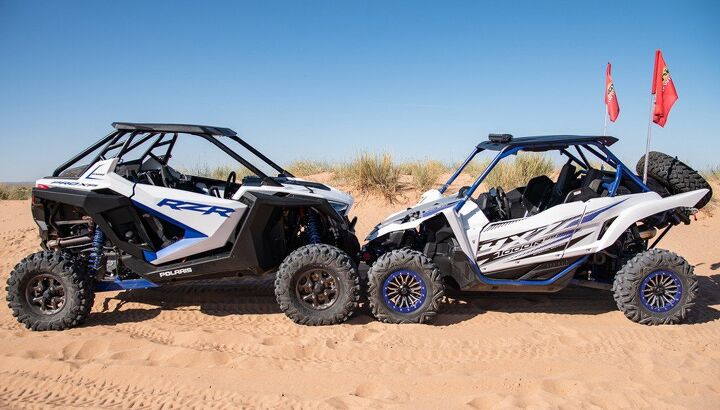



























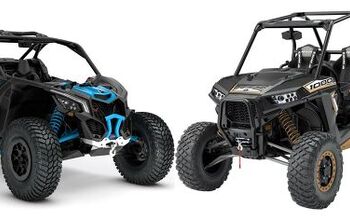
![MIT Student Develops Off-Road Wheelchair [video]](https://cdn-fastly.atv.com/media/2022/10/24/8744100/mit-student-develops-off-road-wheelchair-video.jpg?size=350x220)
![Derek Guetter Crashes During Backflip [video]](https://cdn-fastly.atv.com/media/2022/10/24/8744073/derek-guetter-crashes-during-backflip-video.jpg?size=350x220)
![Unique ATV Tire Bead Breaker [video]](https://cdn-fastly.atv.com/media/2022/10/24/8744118/unique-atv-tire-bead-breaker-video.jpg?size=350x220)
